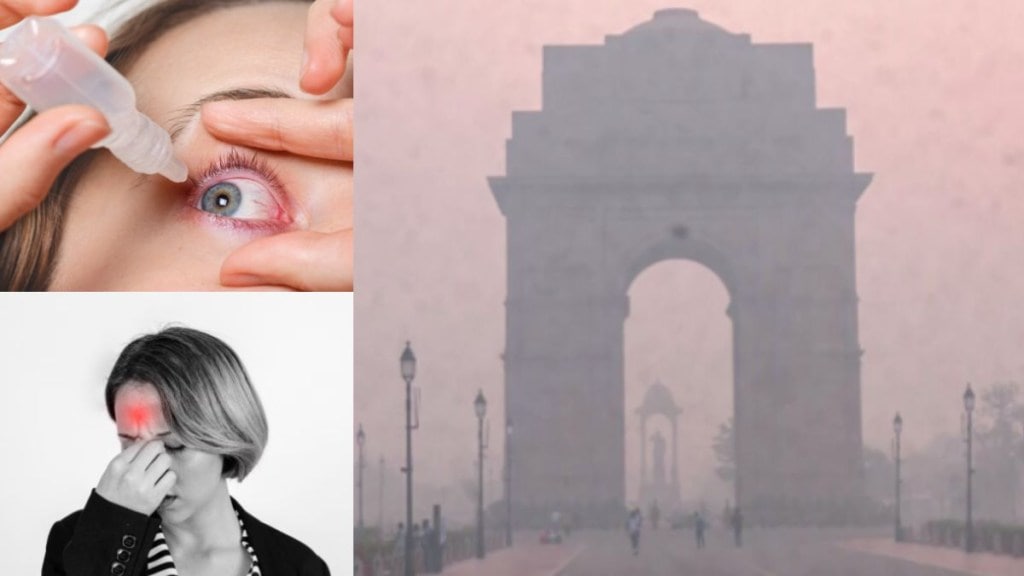Air quality across the Delhi-NCR dropped into the “severe” category on Sunday, creating a toxic haze just ahead of Diwali. Urgent warnings are being issued by health experts, cautioning that the dangerous mix of smog, dust, and firecracker emissions will pose a threat not just to lungs, but also to your eyes.
According to the latest data from AQI.in, Delhi’s city-wide Air Quality Index (AQI) hit 295 at 8:00 am on Sunday, while the Air Quality Early Warning Systems (EWS) registered it at 274. Both fall in the “severe” range, which is a sharp deterioration from the “poor” category seen just a day earlier. The situation on Saturday was already alarming. While many areas clocked an AQI of 255, industrial and high-traffic zones like Ashok Vihar, Wazirpur, and Anand Vihar recorded “hazardous” levels, with AQI between 326 and 412.
To put the toxicity in perspective, AQI.in reported that based on the PM2.5 exposure over the last 24 hours, breathing Delhi’s air is as harmful as smoking approximately six cigarettes a day.
‘Eyes on the front line of pollution’
While respiratory and cardiac risks are well-known, ophthalmologists warn that the eyes are often the first casualty of toxic air.
“Beyond the lungs and heart, the eyes are on the front line of this environmental assault,” said Dr. Prabhjot Kaur, Senior Consultant Ophthalmologist at Dr Agarwals Eye Hospital, New Delhi. “In North India, where winter smog drives the AQI to unhealthy levels, we see an immediate spike in patients with pollution-related eye issues.”
According to Dr. Kaur, the fine pollutants in the air destabilise the eye’s natural tear film and inflame its surface. “When the AQI is poor, short-term symptoms are the most common,” Dr. Kaur explained. “This includes irritation, redness, and a gritty or burning sensation. Many people also experience excessive watering, allergic conjunctivitis, blurred vision, and sensitivity to light as their eyes struggle to cope with the pollutants.”
The danger isn’t just temporary. “With repeated or chronic exposure, the long-term risks become much more serious,” she added. “This includes a higher susceptibility to infections and the development of chronic dry eye syndrome due to the ongoing oxidative stress and inflammation.”
When to see an ophthalmologist
Dr. Kaur advises against ignoring persistent symptoms. “You should seek care from a ophthalmologist if any redness or irritation lasts beyond 24 to 48 hours, or if you experience eye pain, sudden blurred vision, or a thick discharge,” she explains. “A persistent sensation of having something in your eye is also a red flag.”
She noted that some groups must be especially cautious. “Contact lens users, people with diabetes, those with pre-existing glaucoma, children, and older adults should be especially vigilant during this smog season.”
How to protect your vision
Experts say simple, preventive steps are crucial on high-pollution days. The first and best line of defense is simply to limit exposure. This means staying indoors as much as possible, especially during peak pollution hours, and keeping windows securely closed. Inside the home, using an air purifier can make a significant difference in filtering out fine particulate matter. Dr. Kaur also suggests using a humidifier or even a simple bowl of steam, as maintaining indoor humidity can help soothe the eyes. For those working from home, it’s also wise to practice the ’20-20-20 rule,’ taking a break from your screen every 20 minutes to look at something 20 feet away for 20 seconds.
If you do have to go outside, creating a physical barrier is key. Dr. Kaur recommends wearing wraparound glasses or sunglasses to shield your eyes from pollutants. She also strongly advises, “Prefer spectacles over contact lenses on high-AQI days.” This is because pollutants can get trapped under the lens and cause severe irritation. If you’re in a car, keep the windows up and set the air conditioning to “recirculate” mode to avoid pulling in the toxic air from outside.
There are also personal habits that can provide immediate relief. First, “Avoid rubbing your eyes at all costs,” Dr. Kaur warned. “This can worsen inflammation and even scratch the cornea.” Instead, dab gently with a clean tissue or apply a cold compress to settle itching and redness. After coming in from outside, it’s a good idea to rinse your eyes with sterile saline or use preservative-free artificial tears to lubricate and flush out irritants. Finally, staying well-hydrated and adding omega-3 sources like flaxseed, walnuts, and fish to your diet can help support your eye health from the inside out.
“Across North India, eye protection must be a non-negotiable part of pollution precautions,” Dr. Kaur said. “Stay informed, monitor the AQI, and safeguard your vision.”

